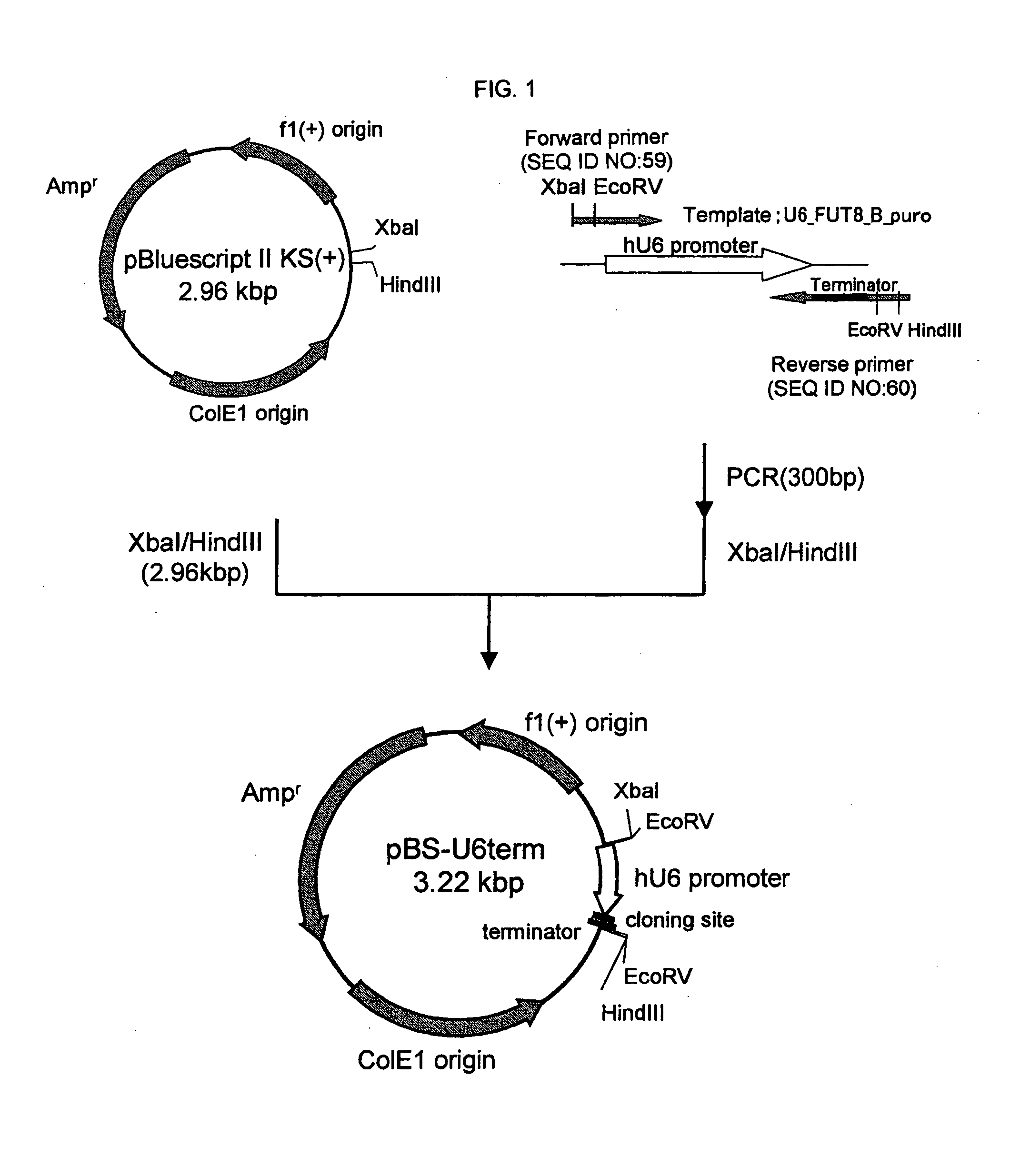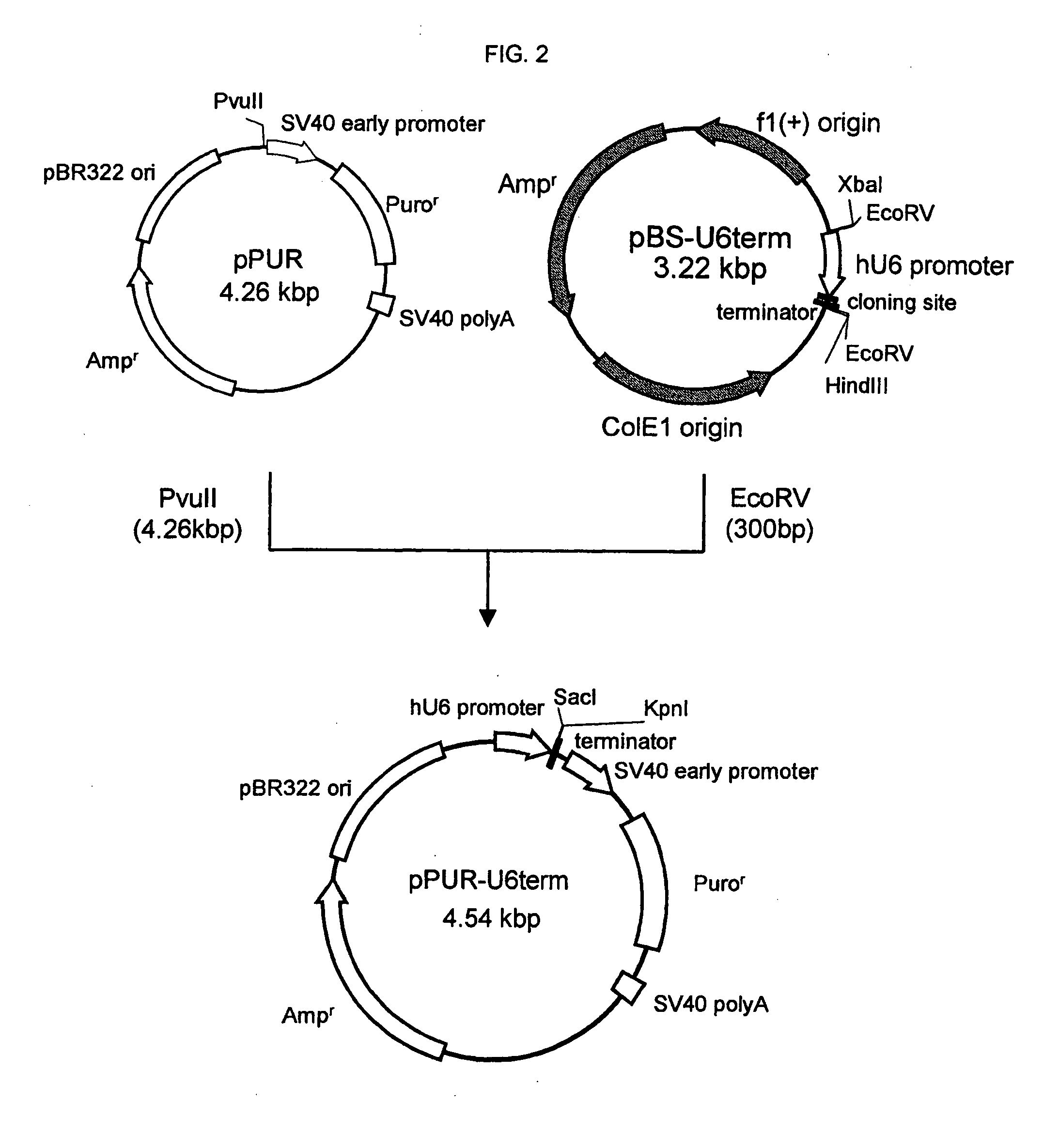Process for producing glycoprotein composition
a technology of glycoprotein and composition, which is applied in the direction of lyase, transferase, immunodeficiency disorder, etc., can solve the problems of inability to produce therapeutic antibodies, inability to surely control the sugar chain structure of produced antibodies, and failure to express antibodies with improved effector activity suitable for application to medicaments
- Summary
- Abstract
- Description
- Claims
- Application Information
AI Technical Summary
Benefits of technology
Problems solved by technology
Method used
Image
Examples
example 1
Preparation of Lectin-Resistant CHO / DG44 Cell by Introducing GMD-Targeting Small Interfering RNA (siRNA) Expression Plasmid:
1. Construction of GMD-Targeting siRNA Expression Vector
(1) Cloning of “Human U6 Promoter-Cloning Site-Terminator” Sequence Expression Cassette
[0440] A “human U6 promoter-cloning site-terminator” sequence expression cassette was obtained according to the following procedure (FIG. 1).
[0441] First, a forward primer in which recognition sequences of restriction enzymes HindIII and EcoRV were added to the 5′-terminal of a nucleotide sequence which binds to human U6 promoter sequence [GenBank Acc. No. M14486] (hereinafter referred to as “hU6p-F-HindIII / EcoRV”, represented by SEQ ID NO:59) and a reverse primer in which recognition sequences of restriction enzymes XbaI and EcoRV, continued 6 adenines bases corresponding to a terminator sequence, and recognition sequences of restriction enzymes KpnI and SacI for insertion of a different synthetic oligonucleotide...
example 2
Production of Antibody Composition Using Lectin-Resistant CHO / DG44 Cell into which GMD-Targeting siRNA Expression Plasmid was Introduced:
1. Obtaining of Antibody Compositions Produced by Lectin-Resistant Clone into which GMD-Targeting siRNA Expression Plasmid was Introduced
[0476] Anti-CCR4 chimeric antibodies produced by lectin-resistant clone 12-GMDB-2 and clone 12-GMDB-5 into which the GMD-targeting siRNA expression plasmid was introduced obtained in Example 1 were obtained according to the following procedure.
[0477] Clone 32-05-12 was suspended in a basal medium and clones 12-GMDB-2 and 12-GMDB-5 were suspended in a basal medium supplemented with 12 μg / mL puromycin (manufactured by SIGMA) at a density of 3×105 cells / mL, and they were inoculated at 15 mL into a T75 flask for adherent cells (manufactured by Greiner). After culturing under conditions of 5% CO2 and 37° C. for 6 days, the culture supernatant was removed, and after washing twice with 10 mL of Dulbecco's PBS (manuf...
example 3
Serum-Free Fed-Batch Culture of Lectin-Resistant CHO / DG44 Cell into which GMD-Targeting siRNA Expression Plasmid was Introduced:
1. Adaptation of Lectin-Resistant CHO / DG44 Cell into which GMD-Targeting siRNA Expression Plasmid was Introduced to Serum-Free Medium
[0481] The parent clone 32-05-12 before vector introduction, and lectin-resistant clones 12-GMDB-2 and 12-GMDB-5 into which the GMD-targeting siRNA expression plasmid were introduced obtained in Example 1 were adapted to a serum-free medium according to the following procedure.
[0482] Clone 32-05-12 was suspended in a basal medium and clones 12-GMDB-2 and 12-GMDB-5 were suspended in a basal medium supplemented with 12 μg / mL puromycin (manufactured by SIGMA) at a density of 3×105 cells / mL, and each was inoculated at 5 ml into a T75 flask for adherent cells (manufactured by Greiner). After culturing under conditions of 5% CO2 and 37° C. for 3 days, cell suspension was obtained by trypsin treatment, and cells were recovered b...
PUM
| Property | Measurement | Unit |
|---|---|---|
| concentration | aaaaa | aaaaa |
| concentration | aaaaa | aaaaa |
| concentration | aaaaa | aaaaa |
Abstract
Description
Claims
Application Information
 Login to View More
Login to View More - R&D
- Intellectual Property
- Life Sciences
- Materials
- Tech Scout
- Unparalleled Data Quality
- Higher Quality Content
- 60% Fewer Hallucinations
Browse by: Latest US Patents, China's latest patents, Technical Efficacy Thesaurus, Application Domain, Technology Topic, Popular Technical Reports.
© 2025 PatSnap. All rights reserved.Legal|Privacy policy|Modern Slavery Act Transparency Statement|Sitemap|About US| Contact US: help@patsnap.com



